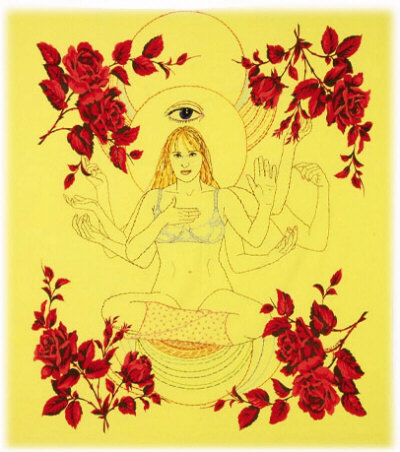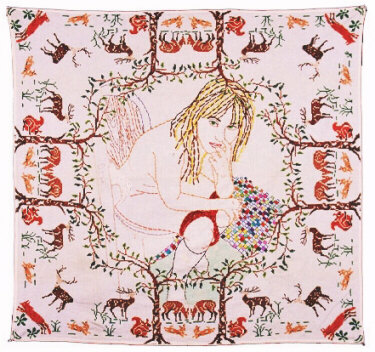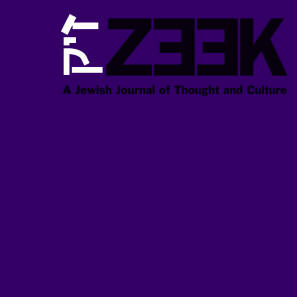 December 06
December 06
Religion and Insanity
Jay Michaelson
 1. Mother Eagle
1. Mother Eagle
A friend of mine is getting into angels, and I don't know what to do.
The problem is that for the last several years, my spiritual path has been about more openness, more sensitivity, and more awareness to the subtle shifts of energy that otherwise escape our notice. Beginning on my first meditation retreat, years ago, I've learned that the reflexive doubt and cynicism which I had been so proud of, and which are such fixtures in contemporary literary culture, are often not the sophistication they pretend to be, but a defense mechanism, bespeaking not cultured sophistication but shame, fear, or even ignorance. I've learned this through my own subjective experience, and through conversations and interactions with other people: what seems to be analytical cleverness is often a kind of cowardice.
So a cultivated openness -- not erasing doubt and judgment, but suspending them long enough for experience to really unfold -- is the key. Significant shifts do sometimes occur. Only a few years ago, for example, I asked in this magazine whether "energy" was real, or nonsense. But then, a while later, while working with Body Electric massage techniques, I experienced it myself: how, with my hands inches above my partner's body and with his eyes closed, I could cause "energetic" changes in his body. I moved, and he moved; I concentrated energy, and he shook. Weird, yes -- perhaps so weird that, as one of my editors once told me, I lose credibility by talking about it. But also a phenomenon with no other explanation that I've been able to generate. I still don't know what energy is, but I know that there is more to heaven and earth than is dreamt of in scientific-materialist philosophy.
But openness still has its limits. As my excursions into the New Age progress, I've met weirder and weirder people. Usually, that's a good thing; the world would be a lot better off with more weird people than more normal ones, and "weird" is often a reduction of "wise." Other times, though, weird is just weird. I find myself having moments a bit like the scene in Augusten Burroughs' Running with Scissors, when Dr. Finch, the oddball psychiatric Svengali who acts as a surrogate father for Burroughs, says that the shapes of his bowel movements are messages from God. We've wondered about Finch's sanity throughout the book (and film), but in that moment, we realize that he has been nuts all along. In a narrative searching for a sane center, Finch reveals that he isn't going to be it.
So, when my friend tells me that he's communing with Mother Eagle and reading Tarot cards, I don't know what to do. On the one hand, I want to be open. On the other hand, I don't believe in the things he believes in, and don't see how a sane person could. To begin with, as Sam Harris has lately shown in his books, mythic religion isn't a harmless eccentricity. In the case of Mother Eagle, sure -- but in the case of Jesus Christ and Muhammad, it's causing war all around the world. You're either born again or you give offerings to Krishna. You're either part of the chosen people or you're a faithful Muslim. I've written about this before; how, in the Jewish world, the trigger for religious experience becomes "fetishized," and fundamentalism is reinforced. To repeat the Sufi tale I quoted a year ago:
There was once a prisoner who yearned for freedom. One day, the prophet Mohammed appeared to him, and gave him a set of keys to his cell, saying "Your piety has been rewarded. Allah has set you free." So the prisoner took the set of keys, mounted them on the wall, and prayed to them five times a day.
Of course, few New Age practitioners are ethnocentric or violent. On the contrary, they love all spiritual practices -- darshan, deeksha, davening, whatever -- because these practices are understood functionally, in terms of what they do for the self. Certainly, in my own life, I'm not fighting crusades or jihads. But I see how my own religious beliefs cause me to be a little more violent in my own, limited, domain. When Friday evening is approaching and I'm not ready, I get antsy, angry, and tense. I lash out at myself or other people. I get really pissed if my kosher meal gets lost by the airline. And those peaceful New Age meditators? Watch what happens if you move their sacred yoga mat.
Still, contra Sam Harris, it does seem to me that non-mythic religion successfully avoids the problems of violence and ethnocentrism that seem an inexorable part of mythic religion. Meditation provides the same sense of groundedness that religion provides, except that it is grounded in real, transitory, moment-to-moment experience rather than in myth, tribe, or code. Contemplation opens the heart, and makes one more, rather than less, appreciative of other religious paths. Indeed, that is a big part of the point.
But even if we set aside the dangers of myth, and recognize that, with the right pluralistic and contemplative training, many of them can indeed be avoided, there's still the beliefs themselves.
2. Don't worry, it's just an archetype
The most obvious way in which religious beliefs seem disconnected from rationality is when they make claims about reality that fly in the face of available evidence. For example, Rev. Ted Haggard, before he stepped down as president of the National Association of Evangelicals amid accusations that he paid a man for sex (repeatedly, over a period of three years -- and did crystal meth to boot), told Barbara Walters that heaven was a real, physical place, beyond the known universe, where you could eat all you want and never get fat, and where there were mansions for all the faithful. Such ideas, like the belief in a physical Devil (held by 70% of Americans, according to Pew Institute surveys) or the notion that Christ will appear on Earth in the next 50 years (held by 50%), are so tied to supernatural myth, superstition, and unquestioned traditions received from authority, that modern and postmodern people can easily raise their eyebrows at anyone who hold them.
Intelligent spiritual practitioners today, and non-reductive scholars of religion, often take a different approach, which attempts to preserve the integrity of religious belief per se, even while dismissing the actual contents of those beliefs: to interpret mythic language in non-mythic terms that renders it scientifically OK. As Maimonides observed 850 years ago, the genius of religion is that it works on multiple levels. Yes, ordinary people really believe the myths -- that there is a Mother Eagle out there, or a physical place called heaven, and a creation in seven earthly days -- and that helps them order their lives, be more ethical, and have a sense of the sacred. Philosophers -- that is, those of us with the privilege and aptitude for reflective thought -- know that these myths aren't literally true, but that they still contain important truths, and truths which, when reduced to concept, are hard for most people to wrap their heads around, or care about. Thus all myth can be stripped of its dubious truth-value, and appreciated for its deep power to inspire.

So, following the Rambam, and modern Reconstructionist Judaism, and Unitarianism, and countless other thinkers and movements who have sought to demythologize religion while not dismissing it either, Mother Eagle isn't really a being, out there, with a consciousness and a self. She's an archetype, a representation of something deep in our unconscious -- and more power to my friend for finding imagery to access it. Likewise, it's not that the Tarot cards are really magic; they just give his own deeply skilled intuition a structure in which to operate.
The question, as I wrote about in Levels in Religion this past summer, is simply one of interpretation. Anyone can have a religious experience, but, as Ken Wilber develops at great length, that experience will be interpreted according to their stage of intellectual/emotional development. So, we just have to acknowledge that similar experiences will be interpreted in different ways -- and, if we're Wilber, own up to the fact that some interpretations are indeed better than others.
Fair enough in theory, but put into practice, there are at least three problems with it, at least one of which, I think, is fatal.








